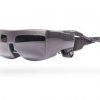Technology holds new promise for improving quality of life for the visually impaired. We've found three innovations that could very soon be changing lives around the world, offering hands-free, mobile vision correction.
Visor
While virtual reality is often thought of as a temporary escape from banal reality, this medical innovation by the team at Colorado-based Gizmonyx uses it to bring the real world to those with a narrow field of vision, transferring it to them digitally to increase their quality of life. Called the Visual Information Stimulated Optical Reflector (VISOR), it also employs bone conduction technology, allowing users who are legally blind to recognise faces and read text as well as discern the size, shape, distance and colour of objects in their surroundings. The product was featured at the 2014 TEDMED conference this month in Washington DC and San Francisco. Watch it in action here. The release is expected for June 2015.
www.gizmonyx.com
OrCam
A team in Tel Aviv has developed a discreet camera that attaches to glasses frames. It enables the user to read printed text in real time and recognise personal objects, and it is said to be highly responsive to the user. It works by sharing visual sensory elements with the user by means of bone conduction technology, which transmits sound to the user's central nervous system. It became available in the U.S. in 2013 and other countries are to follow as the device is adapted to different languages. OrCam is intended for the visually impaired and may not be suitable for those who are unable to select a point of interest in their vision field. US$3,500 (RM11,400).
www.orcam.com
eSight
For the legally blind and those with low vision, eSight combines a camera, display technology and advanced computing to deliver a real-time video that makes one's surroundings snap into focus. It allows users to view faces, watch TV and movies, read text and autofocus on short, medium and long-range objects. It's been approved by the FDA and has been available since 2013 at low-vision clinics in the US and Canada. US$15,000. (RM49,000)
www.esighteyewear.com
source:AFP
Modern Miracles: Three Devices That Help The Blind See

